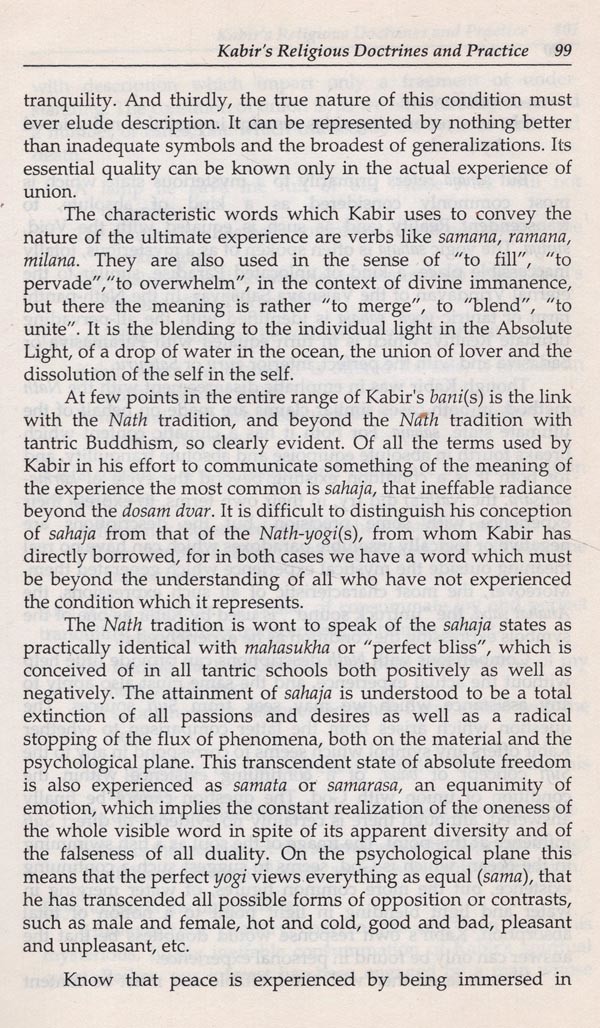
| Item Code: | UBC425 |
| Author: | S. R. Bakshi, Sangh Mittra |
| Publisher: | Criterion Publications, Delhi |
| Language: | English |
| Edition: | 2002 |
| ISBN: | 8179380076 |
| Pages: | 346 |
| Cover: | HARDCOVER |
| Other Details | 9.00 X 6.00 inch |
| Weight | 530 gm |
Saint Kabir is counted among the few well- known poets of his age. His poetry is simple, lucid in style and devoid of any kind of complexity. It is indeed for the common man and his welfare. His verses are studied with much interest by teachers and students. His writings are prescribed even at the university stage. The text contains nine chapters which include his simple way of living, the social condition of his age, his religious views which he lucidly depicted in his poetry, the concept of Bhagats, Kabir's language and last but not the least, some of his selected poems which have deep bearing on the working of his mind and philosophy of life.
This work would be quite interesting for teachers, research scholars, students and other learned persons who would be interested in the poetic philosophy, with human touch, of Saint Kabir.
Contents include: Kabir's Life Sketch; Kabir and his Times; Kabir's Religious Doctrines and Practice; The Bhagats; Kabir's Language and Languages; Selected Poems; Kabir's Bhakti; Efficacy of Bhakti; Kabir's Verses.
Dr. S.R. Bakshi, Ph.D., D.Litt. is an eminent. scholar of Modern Indian History and is the author of several works on Indian nationalism and freedom movement. His recent works include 'Encyclopaedic History of Indian Culture and Religion' (in 5 Vols.), The Great Marathas' (in 5 Vols.), The Great Rajputs' (in 6 Vols.), 'B.R. Ambedkar: His Political and Social Ideology' (in 2 Vols.), 'Encyclopaedic History of The Sikhs and Sikhism' (in 6 Vols.), The Great Moghuls' (in 8 Vols.), and Development of Women, Children and Weaker Sections' (in 5 Vols.). Dr. Bakshi is member of several academic institutions having deep bearing on historical research.
Dr. Sangh Mittra, LL.B. Ph.D. from Lucknow University, is Dy. Director (Research) in Indian Council of Historical Research. Her Ph.D. thesis on 'Iconographic Study of Minor Brahmanical Deities in Northern India' is published along with more than 20 Research Papers in reputed historical journals. She is Life Member of several academic institutions and a reputed examiner of Ph.D. thesis of Universities of North India. Besides she has actively participated in numerous national and international Seminars.
It has been well remarked about Kabir. What a wonderful man Kabir must have been? A lowly Muslim weaver who by a stratagem gained accession to a Vaishnav community, universally despised and hated by both Mussalman and Hindu, maltreated by the Muslim emperor and persecuted by the Brahmanhood of Benaras with unparalleled audacity he dared to act himself face to face against both Islam and Hinduism, the two religions of the 15th century India and won through. Each he attached in its tenderest point-as shibboleths and its rituals and both rode triumphant, teaching and converting thousands who became his devoted followers. Not only did he find an eclectic monotheism that survives in India till the present day, but he became the spiritual father of Guru Nanak who founded Sikhism.
Born as a Muslim Julaha and living about Benaras, Kabir certainly was conversant with the dominant provincial language, Avadhi, and he was probably more familiar with it than with rural Bhojpuri. 'Indifferent or opposed to traditional beliefs and values, apparently unconcerned with the pleasure or displeasure of his audience, Kabir fearlessly voices his inner conviction. His blunt language, his bitter irony bespeak ardent indignation, but also a desperate effort to awaken his dumb, sleepy fellow men, unaware of their impending doom.
Being a man of the people, a poor artisan, Kabir could hardly have had any formal religious training what he knew, he knew from experience or from hearing alone. There is no doubt that he was one who had heard much. Living around Benaras, he must have been in constant contact with the holy men of his time: Pandit, yogis, Shaiva sannyasis and Vaishnav Bairagis, Vira Shaiva, Jangamas, Munis and Tapis-ascetics of every role and denomination: the motley crowd of saints and sadhus which filled, even as today-the narrow lanes of the holy city, Varanasi.. During the time of Kabir, the bhakti school of thought was in vogue in North India and the 'bleeding soul' of the Hindus of that time found consolation in the wisdom of compassion, benevolence and self-surrender to Krishna or Rama.
Men, women and children found aesthetic, moral and spiritual food in the personality of Krishna and received the spiritual upliftment and ecstasy, moral and spiritual. Poets of outstanding ability and of a cosmopolitan outlook on life sang of Krishna and Ram in their sweet and immortal songs in the Hindi language, indeed the language of the masses. Though the India of the time of Kabir was characterised by misrule and chaos, yet there was great religious activity and literary upheaval to the vernacular.
A Brahman virgin widow is said to have given birth to the child who was subsequently called Kabir. All his followers agree that he was brought up in the house of a Muslim named Nur Ali or Nura, a weaver, whose wife was named Nima. He was a precocious child. From his childhood, the religious quest seems o have been his favourite pursuit. He did not identify himself with either Hinduism or Islam.
**Contents and Sample Pages**














Send as free online greeting card
